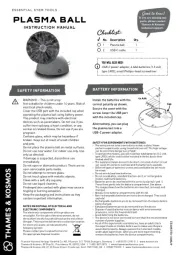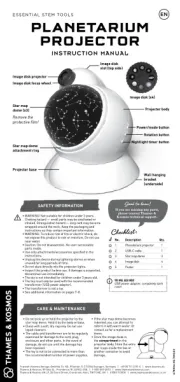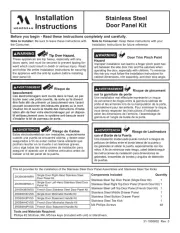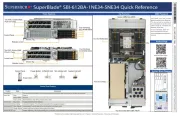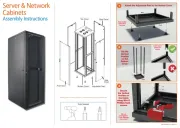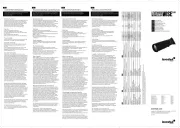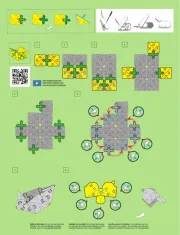
Safety information
Warning! Not suitable for children
under 8 years. For use under adult
supervision. Read the instructions
before use, follow them and keep them
for reference.
Keep small children and animals
away from experiments. Keep the
experimental set out of reach of
children under 8 years old.
Warning. Not suitable for children
under 3 years. Choking hazard — small
parts may be swallowed or inhaled.
Keep the packaging and instructions as
they contain important information.
The lollipops must be stored in an
airtight container and consumed within
one week.
All of the tools should be cleaned by
hand before and after use.
Read this before starting any
experiments.
1. Read these instructions before use,
follow them and keep them for reference.
2. Keep young children and animals away
from the work area and stove at all times.
3. Store this kit out of reach of children
under 8 years of age.
4. Clean all equipment after use. Clean
all pots and utensils with hot water and
soap.
5. Do not use any equipment which
has not been supplied with the set or
recommended in the instructions for use.
6. Never work alone. An adult should
always be present. Pay attention to
the information provided with each
experiment.
7. Pay special attention to the quantity
specifications and the sequence of
the individual steps. Only perform
experiments that are described in this
instruction manual.
8. The included plastic mold for the
lollipops is not dishwasher safe. It will be
deformed by high temperatures, so wash
it by hand.
9. Clean the work surface carefully after
you are finished and always wash your
hands thoroughly — before and after you
work.
10. If you are allergic to certain foods
you must avoid sweets that contain such
ingredients. Therefore, always begin by
checking the list of ingredients. If you are
diabetic, you must only eat the amount of
sugar allowed by your diet plan.
11. It goes without saying that there can
be no smoking in a confectionery shop.
Safety rules
First aid information
Advice in case any accidents should
happen during experimentation.
1. In case of burns: Wash affected area
with plenty of water for at least 10
minutes.
2. In case of doubt or larger burns, seek
medical advice without delay.
3. In case of injury (e.g. cuts) always
seek medical advice.
Common Cooking Conversions
In cooking and in science, you use many different measurements, but sometimes the units are
a bit different. In the United States, we usually use United State Customary Units for cooking
measurements. Scientists around the world however have agreed to use the International
System of Units (also called the metric system) so that everyone can communicate data more
easily. This table helps you convert between the two systems.
When you know this: Multiply by this: To get the metric equivalent:
cups 236.6 milliliters (ml)
cups 0.236 liters (l)
teaspoons 4.93 milliliters (ml)
tablespoons 14.79 milliliters (ml)
quarts 0.946 liters (l)
gallons 3.785 liters (l)
fluid ounces 29.57 milliliters (ml)
ounces (mass) 28.35 grams (g)
Fahrenheit (°F)
subtract 32, multiply by 5,
and divide by 9
Celsius (°C)
Other Helpful
Conversions
1 gallon = 4 quarts =
8 pints = 16 cups =
128 fluid ounces
1 cup =
8 fluid ounces =
16 tablespoons =
48 teaspoons
How many teaspoons?
Each batch of lollipops calls for 180 milliliters (ml) of sugar. How many teaspoons is that?
First you need to know the conversion factor:
Now you can use division. What is 180 ml divided by 5 ml? Or in other words, how many
times does 5 go into 180? You can represent this visually too.
= 36 tsp
5+5+5+5+5+5+5+5+5+5+5+5+5+5+5+5+5+5+5+5+5+5+5+5+5+5+5+5+5+5+5+5+5+5+5+5 ml = 180 ml
1 teaspoon = 5 ml
Temperature Consistency Uses
>350 °F
>176 °C
Burnt Sugar — turns black,
smokes, and smells bad
Should not be eaten
320-330 °F
160-166 °C
Caramel — golden smells like
yummy caramel
Caramel, pralines
295-310 °F
146-154 °C
Hard Crack — breaks like glass
when cooled
Hard candy, drops, lollipops
270-290 °F
132-143 °C
Soft Crack — elastic strings
that will partly break
Taffy, toffee, cream candy,
butterscotch
250-266 °F
121-130 °C
Hard Ball — can be formed
with wet fingers into a ball
Nougat, gummy candy
244-248 °F
118-120 °C
Firm Ball — easily formed, but
still sticky
Chewy candy,
marshmallows
234-240 °F
112-115 °C
Soft Ball — can be formed, but
will lose its shape again
Fondant (a soft, creamy
sugar base for icing)







